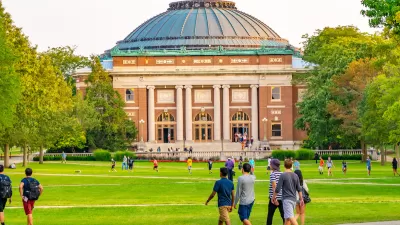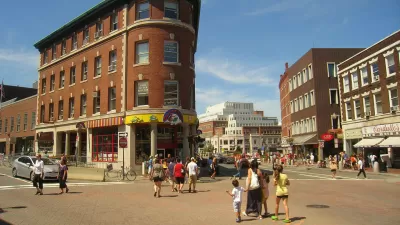Based on empirical study, J. Alexander Maxwell and fellow University of Strathclyde researchers, in collaboration with Chuck Wolfe, argue for recalling historic patterns of pedestrian city settings in contemporary urban design and policies.

In a recent study, J. Alexander Maxwell and fellow researchers from the University of Strathclyde’s Urban Design Studies Unit in Glasgow found evidence that before the rise of the automobile, cities developed on a walkable “human” scale, with main streets that rarely exceeded 400 meters (a little more than 437 yards) (the "400-m rule"). Along with Chuck Wolfe, they argue that this uniformity reveals an underlying pattern to pedestrian city settings, which should be considered in contemporary urban design and policies.
They note:
Some elements of our urban environments change relatively quickly over time. New shops replace old shops, new buildings replace old buildings, and people come and go. However, other elements are more permanent and often reflect the planning policies, design paradigms, and technologies of the times when they were built. In a sense, these surviving features provide snapshots of our urban histories.
Among their preliminary explorations was a test of the 400-m rule against 100 historically diverse main street networks from cities in 30 different countries around the world. Figures illustrate historic cases, including main street networks from groupings of ancient, medieval, renaissance, baroque, and industrial study areas. Post-industrial cases included main street networks from groupings of Garden City, Radiant City, New Urbanism, and informal settlement patterns of development.
The results of this empirical study suggest that the observational claims behind the 400-m rule are in fact true.
The authors opine that the uniformity of the findings suggests an "effortless" expression of human tendencies – a signature that should be honored by policy and design consistent with this established norm.
Their conclusion illustrates typologies of liveable communities that attempt results that are very similar to the 400-m rule, and provides a call to action:
[M]ore conscious study is needed to tie together past and present. If underlying patterns of human-scale design in urban settings can be captured from historic environments and reapplied in contemporary policy and implementation contexts, then new purpose can be realized from past realities.
FULL STORY: City main street networks show a drastic shift away from historic patterns of human-scale design

Alabama: Trump Terminates Settlements for Black Communities Harmed By Raw Sewage
Trump deemed the landmark civil rights agreement “illegal DEI and environmental justice policy.”

Planetizen Federal Action Tracker
A weekly monitor of how Trump’s orders and actions are impacting planners and planning in America.

The 120 Year Old Tiny Home Villages That Sheltered San Francisco’s Earthquake Refugees
More than a century ago, San Francisco mobilized to house thousands of residents displaced by the 1906 earthquake. Could their strategy offer a model for the present?

Ken Jennings Launches Transit Web Series
The Jeopardy champ wants you to ride public transit.

BLM To Rescind Public Lands Rule
The change will downgrade conservation, once again putting federal land at risk for mining and other extractive uses.

Indy Neighborhood Group Builds Temporary Multi-Use Path
Community members, aided in part by funding from the city, repurposed a vehicle lane to create a protected bike and pedestrian path for the summer season.
Urban Design for Planners 1: Software Tools
This six-course series explores essential urban design concepts using open source software and equips planners with the tools they need to participate fully in the urban design process.
Planning for Universal Design
Learn the tools for implementing Universal Design in planning regulations.
Clanton & Associates, Inc.
Jessamine County Fiscal Court
Institute for Housing and Urban Development Studies (IHS)
City of Grandview
Harvard GSD Executive Education
Toledo-Lucas County Plan Commissions
Salt Lake City
NYU Wagner Graduate School of Public Service





























